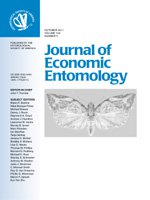A population model was derived for light brown apple moth, Epiphyas postvittana (Walker) (Lepidoptera: Tortricidae), subject to the sterile insect technique (SIT). The model was parameterized from the literature and from recent laboratory studies conducted in New Zealand and Australia. Relationships were fitted for several model parameters that vary with irradiation dose, allowing the model to simulate effectively complete sterility at 300 Gy through inherited sterility occurring from lower doses. At 300 Gy, the model suggests that eventual population extinction is 95% probable when the ratio of released to wild males in monitoring traps exceeds 6.4. Higher overflooding rates would be required to achieve eradication more rapidly. The optimal release interval, in terms of minimizing the required rate of production of factory moths, is approximately weekly. There is little advantage in releasing males only compared with releasing both sexes. Female-only releases are unlikely to be a useful tool for inherited sterility eradication because there is no reduction in the fertility of F1 offspring. The critical release rate required to halt population increase declines with decreasing irradiation dose, but at doses of <171 Gy there is a risk that irradiated-lineage moths may form a self-sustaining population, making eradication by SIT alone impossible. The model suggests that a dose of around 200 Gy may be optimal because the resulting inherited sterility would reduce by a third the number of factory moths required compared with 300 Gy.
How to translate text using browser tools
1 October 2011
Modeling the Sterile Insect Technique for Suppression of Light Brown Apple Moth (Lepidoptera: Tortricidae)
John M. Kean,
David Maxwell Suckling,
Lloyd D. Stringer,
Bill Woods
ACCESS THE FULL ARTICLE
It is not available for individual sale.
This article is only available to subscribers.
It is not available for individual sale.
It is not available for individual sale.

Journal of Economic Entomology
Vol. 104 • No. 5
October 2011
Vol. 104 • No. 5
October 2011
delayed differential equation model
Epiphyas postvittana
eradication
irradiation biology




